语言学整理
《语言学纲要》知识点整理

《语言学纲要》知识点整理《语言学纲要》是一本深入浅出地介绍了语言学主要概念和理论的教材。
全书共分为八章,包括语言学的起源和发展、语言学的分类、语言的结构与功能、语言的演变、语言与社会、语言习得与教学、语言与文化、应用语言学等内容。
下面整理了该书的主要知识点,以便大家更好地理解和学习。
1.语言学的起源和发展-语言学的定义和研究对象-研究语言的主要学派及其代表人物-语言学的分类及其特点2.语言学的分类-语音学:研究语音的产生、传播和接受的规律-词汇学:研究词汇的形成、结构和意义的规律-语法学:研究句子的结构和组成成分之间的关系-语义学:研究语言单位的意义和语义关系的规律-语用学:研究语言使用的背景、目的和效果的规律3.语言的结构与功能-语音的基本要素:音节、音位、语调等-词汇的分类及其特点:实词和虚词、专用词和普通词等-句子的成分和结构:主语、谓语、宾语等-语言的功能:交际功能、表达功能和认知功能等4.语言的演变-语言变异和语言变种:方言、口音等-语言变迁和语言变异的原因:历史、地理、社会等-语言接触和语言借用:外来语的影响和借词现象-语言变化的规律和趋势:语音演变、词汇演变等5.语言与社会-社会语言学的基本理论和方法-语言社会化和语言规范化:语言的习得、使用和变异的规律-语言地位和语言权力:标准语和方言的关系-语言与身份认同:地域、阶级、性别等对语言的影响6.语言习得与教学-语言习得的理论和过程:母语习得和第二语言习得-语言教学的理论和方法:教学目标和任务、教学材料和教学法-第二语言习得的问题和难点:语音、词汇、语法等方面-语言评价和测试:能力级别、智力水平等7.语言与文化-语言与文化的关系:语言是文化的载体和反映-语言与文化的差异:语义、词汇、语法等方面-语言的文化功能:人际交往、思维方式、文化传承等-语言的跨文化交际能力:语言障碍与跨文化交流8.应用语言学-应用语言学的定义和发展:语言学在实际问题中的应用-语言规范和语言政策:标准化、推广普通话等-语言工具和技术:翻译、口译、计算机语言处理等-语言研究的前沿和发展趋势:多语种研究、语料库语言学等。
语言学概论(整理版)

1. “符号”答:符号指根据社会的约定俗成使用某种特定的物质实体来表示某种特定的意义而形成的实体和意义的结合体。
2. “语言”答:语言是言语活动中同一社会群体共同掌握的,有规律可循而又成系统的那一部分,语言是均质的,是言语活动中的社会部分。
语言作为一种社会现象具有鲜明的地区性、民族性和历史性。
3. “普通语言学”。
答:语言学界把研究人类社会的语言这种社会现象的一般理论称为普通语言学。
它以一般语言学为研究对象,探索各种语言所共有的特性、共同的规律、结构上的共同特点和一般原理。
4. “应用语言学”。
答:把语言学的理论和具体成果用来为社会实际生活中的某个领域服务,这是广义的应用语言学;狭义的应用语言学指专门研究语言教学中的理论和方法。
5. “传统语言学”。
答:一般泛指20世纪以前的语言学,特别是指索绪尔开创的结构主义语言学以前的语言学。
6. “内部语言”。
答:第一,内部语言是语言的一种形式;第二,内部语言的交际对象是说话者本人,且没有出声。
因此,内部语言是没有说出口的内心的话。
7. “语音”。
答:语音是由人的发音器官发出来的表示一定意义的声音。
8. “音高”。
答:音高就是声音的高低,它主要决定于发音体振动频率的高低。
9. “音强”。
答:音强就是声音的强弱,它主要决定于振幅的大小。
10. “音长”。
答:音长就是声音的长短,它是由发音体振动的持续时间决定的。
11. “音质”。
答:音质是一个声音区别于其他声音的个性特征,它决定于声波的形式。
12. “音位”答:音位是从社会功能的角度划分出来的语音单位,它是特定的语言或方言中具有区别意义作用的最小语音单位。
13. “音位变体”。
答:同属于一个音位的不同音素就叫做“音位变体”。
音位变体又可分为“条件变体”和“自由变体”。
条件变体是指出现的语音环境各不相同而又同属一个音位的两个或几个音素。
自由变体是指可以在同一语音环境里出现而又不能区别意义的两个或几个音素。
14. “音位的区别特征”。
语言学整理资料

第一章:语言与语言学A语言的特性:一、任意性与规约性1. 任意性:语言符号的形式与所表示的意义没有天然的联系。
2. 规约性:语言的形式和意义是约定俗称的关系。
二、二层性:指拥有两层结构这种特性,上层结构的单位由底层结构的元素构成,每层都有自身的组合规则。
(有限手段无限使用,人类交际最显著特征)三、创造性:指语言的能产性,这来源于语言的二层性和递归性。
四、移位性:指人类语言可以让使用者在交际时用语言符号代表时间上和空间上并不可及的物体、时间和观点(好处:使得我们有可能用抽象的概念来交流或思考)B与动物语言区别:由于喉部结构的差异,不适合吐字发音。
但可使用手势语言C语言的功能:信息功能人际功能施为功能感情功能寒暄交谈娱乐功能元语言功能D语言学的发展脉络:一、传统语言学:1.从哲学角度思考(名实之争):区分主语、谓、宾等逻辑成分概念、对语言起源问题的讨论2. 语文学习角度研究(梵文):为阅读理解古代经典文献服务的3. 历史比较角度(主要比较印欧语系):试图通过语言亲属关系的比较研究语言的发展规律,拟测它们共同母语(提供了科学的方法)二、现代语言学(20c,结构语言学)语言是一个符号系统,提出语言的线条性、任意性、“能指”(符号可感知)与“所指”(符号所代表的内容)、“组合关系”(两个同一性质的结构单位按照线性顺序组合的关系)与“聚合关系”(某一位置能够互相替代)(区分历时)更强调共时研究,重视排除历史干扰而对语言现状进行现实的描写区分“内部语言学”和“外部语言学”,认为语言学首先要进行语言系统和系统内部各个要素的研究。
E当代语言学三个主要流派的基本思想:生成语言学派:语言是人类内在化的能力,人类语言虽然差别很大但遵循的原则相同。
强调语法的天赋性、自主性,着重探索人类语言的机制、共性,同时探究各个语言的参数差异,即在探索人类语言共性的基础上探究各个语言的特点。
天赋假设:语言是天赋,儿童生下了就有普遍语法,婴儿言语获得过程是先天的“语言习得机制”。
语言学术语整理

语言学常用术语整理1、传统语法:传统语法是指代表前语言学时期语言研究的特征、特别是18和19世纪欧洲学校语法特征的一系列的看法、程序和规定的语法。
后来被结构主义语言学取代,现代中学教学所用的语法都是传统语法。
传统语法的内容:①把语法分为形态学(词法)和造句法(句法)两大部分,以词法为主,详细讲解各类词在句子中的形态变化和语法作用。
句法往往比较简单,主要为词法服务。
②建立了形态学,研究语法形态和语法意义的对应关系。
③建立了句法成分,主语、谓语、为主要成分,宾语、补语是次要成分,定语、状语是附加成分。
传统语法的特点:①它是规范性的语法,由语法学家订立一些条文,规定人们应该怎么说,不应该怎么说,不顾语言事实。
②它重视书面语,比较少或干脆不考虑口语。
③以拉丁语为楷模,它研究语法照搬拉丁语法框架。
④语言分析中重视意义,忽视形式。
⑤忽视语言结构层次。
贡献:虽然传统语法有许多缺点,但它作为语言学史上的第一个语法学派奠定了语法学基础,对普及语法知识起到了巨大的作用;虽然现在语法学派林立,但名词、动词、形容词、语法形式、语法意义、语法手段、主语、宾语等语法范畴在各学派的体系中仍然使用,所以说传统语法对语法学具有开创作用。
2、结构主义语法:结构主义语法是在对传统语法评判的基础上建立起来的,创始人是瑞士语言学家索绪尔,经典著作是《普通语言学教程》,提出了一整套语言学理论。
后来发展成三个分支学派:布拉格学派、哥本哈根学派和美国描写语言学派。
其中以美国描写语言学派的影响最大,代表人物是布龙菲尔德,集大成者是哈里斯。
结构主义语法的基本主张:①语法只能是描写语言,即说明人们怎样说一种语言,而不能像传统语法那样规定人们该怎么说。
②语法必须从形式出发描写语言,而不是像传统语法那样从意义出发来探讨语言。
提出根据分布划分词类。
③强调语言的内部层次,提出用“直接成分分析法”对句法结构进行分析。
④语言单位切分的方法:替代法、分布、转换法、对比分析法。
英语语言学知识整理
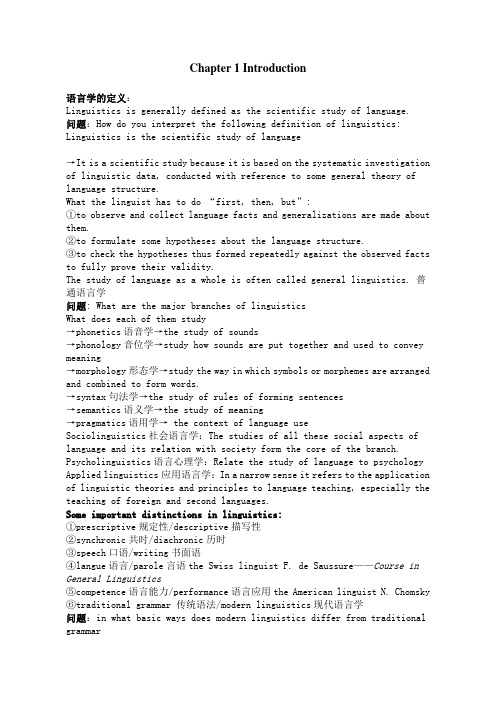
Chapter 1 Introduction语言学的定义:Linguistics is generally defined as the scientific study of language.问题:How do you interpret the following definition of linguistics: Linguistics is the scientific study of language→It is a scientific study because it is based on the systematic investigation of linguistic data, conducted with reference to some general theory of language structure.What the linguist has to do “first, then, but”:①to observe and collect language facts and generalizations are made about them.②to formulate some hypotheses about the language structure.③to check the hypotheses thus formed repeatedly against the observed facts to fully prove their validity.The study of language as a whole is often called general linguistics. 普通语言学问题: What are the major branches of linguisticsWhat does each of them study→phonetics语音学→the study of sounds→phonology音位学→study how sounds are put together and used to convey meaning→morphology形态学→study the way in which symbols or morphemes are arranged and combined to form words.→syntax句法学→the study of rules of forming sentences→semantics语义学→the study of meaning→pragmatics语用学→ the context of language useSociolinguistics社会语言学:The studies of all these social aspects of language and its relation with society form the core of the branch. Psycholinguistics语言心理学:Relate the study of language to psychology Applied linguistics应用语言学:In a narrow sense it refers to the application of linguistic theories and principles to language teaching, especially the teaching of foreign and second languages.Some important distinctions in linguistics:①prescriptive规定性/descriptive描写性②synchronic共时/diachronic历时③speech口语/writing书面语④langue语言/parole言语the Swiss linguist F. de Saussure——Course in General Linguistics⑤competence语言能力/performance语言应用the American linguist N. Chomsky⑥traditional grammar 传统语法/modern linguistics现代语言学问题:in what basic ways does modern linguistics differ from traditional grammar①linguistics is descriptive while traditional grammar is prescriptive.②modern linguistics regards the spoken language as primary, not the written.③modern linguistics does not force languages into a Latin-based framework.问题:Is modern linguistics mainly synchronic or diachronicWhyIn modern linguistics, a synchronic 不考虑历史演进的, 限于一时的 approach seems to enjoy priority over a diachronic 探求现象变化的, 历时的 one. Because it is believed that unless the various states of a language in different historical periods are successfully studied, it would be difficult to describe the changes that have taken place in its historical development. Synchronic descriptions are often thought of as being descriptions of language in its current existence, and most linguistic studies are of this type.问题:For what reasons does modern linguistics give priority to speech rather than to writingFrom the point of view of linguistic evolution, speech is prior to writing. The writing system of any language is always “invented” by its users to record speech when the need arises. Even in today’s world there are still many languages that can only be spoken but not written. Then in everyday communication, speech plays a greater role than writing in terms of the amount of information conveyed.Spoken language reveals more true features of human speech while written language is only the “revised” record of speech. And linguists’ data for investigation and analysis are mostly drawn from everyday speech, which they regarded as authentic.语言的定义:Language is a system of arbitrary vocal symbols used for human communication. Design features of language7个识别特征①arbitrariness 任意性 at the syntactic level②productivity 能产性,创造性Secondary units底层结构 sounds③duality 双层性Primary units 上层结构 units of meaning④displacement 不受时空限制性handle generalization and abstraction⑤cultural transmission 文化传递性⑥interchangeability 互换性⑦convention 约定性Functions of language:三大主要功能:The descriptive functionThe expressive functionThe social functionRoman Jacobson6种首要因素,结构主义语言学家①speaker addresser→emotive 感情功能②addressee→conative 意动功能③context→referential所指功能④message→poetic 诗学功能⑤contact→phatic communion交感功能⑥code→metalinguistic 元语言功能Other functions:①phatic function 问候功能②informative f. 信息功能③interrogative f. 询问功能④expressive f. 表达功能⑤evocative f. 感染功能⑥directive f. 指令功能⑦performative f. 行使权力功能①ideational②interpersonalindicate/establish/maintain/social relationships③textual问题:How is Saussure’s distinction between langue and parole similar to Chomsky’s distinction between competence and performanceThe distinction between langue and parole was made by Saussure, langue is abstract; it is not the language people actually use. Parole is concrete; it refers to the naturally occurring language events. Langue is relatively stable; it does not change frequently, while parole varies from people to people, and from situation to situation.The distinction between competence and performance proposed by the American linguists Chomsky, competence is a deal user’s knowledge of the rules of his language, and the performance is the actual realization of this knowledge in linguistic communication. Imperfect performance is caused by social and psychological factors.Saussure makes this distinction in order to single out one aspect of language for serious study. In his opinion, parole is simple a mass of linguistic facts, too varied confusing for systematic investigation, and that linguistics should do is to abstract langue from parole, ., to discover the regularities governing the actual use of language and make them the subjects of study of linguistics.Similar to Saussure, Chomsky thinks what linguists should study is the ideal speaker’s competence, not his performance, which is too haphazard to be studied.问题:What are the main features of human language that have been specified by C. Hockett to show that it is essentially different from animal communication system①arbitrariness 任意性 at the syntactic level②productivity 能产性,创造性Secondary units底层结构 sounds③duality 双层性Primary units 上层结构 units of meaning④displacement 不受时空限制性handle generalization and abstraction⑤cultural transmission 文化传递性⑥interchangeability 互换性⑦convention 约定性Chapter 2 PhonologyPhonetics: 语音学①the study of the phonic medium of language②look at speech sounds from 3 distinct but related points of view.Ⅰstudy the sounds from the speaker’s point of view→articulatoryphonetics发音语音学Ⅱlook at the sounds from the hearer’s point of view→auditory phonetics 听觉语音学Ⅲstudy the way sounds travel by looking at the sound waves→acoustic phonetics声学语音学③study how sounds are produced, transmitted and perceived.Organs of speech:⒈three important areas①The pharyngeal cavity→the throat② the oral cavity→the mouth③ the nasal cavity→the nose⒉ The pharyngeal cavity→windpipe/glottis/larynx/vocal cords⒊ the oral cavity→tongue/uvula/soft palatevelum/hard palate/teeth ridgealveolus/teeth/lipsInternational Phonetic Alphabet IPA①diacritics 附加符号②broad transcription宽式标音→the transcription with letter-symbols only③narrow transcription严式标音→the transcription with letter-symbolstogether with the diacritics Classification of English speech sounds①two broad categories of speech sounds in English: Vowels/consonants②two ways to classify the English consonants: In terms of manner ofarticulationIn terms of place of articulation ③In terms of manner of articulation:Stops/fricatives/affricates/liquids/nasals/glides④In terms of place of articulation:Bilabial/labiodental/dental/alveolar/palatal/velar/glottal⒈criteria :monophthongs单元音The position of the tongue in the mouth: front/central/backThe openness of the mouth: close vowels/semi-close vowels/semi-openvowels/open vowelsThe shape of the lips: unrounded/rounded/ei //ai //au //u //i //i //ε// u /Phonology 音韵学,语音体系Difference of phonology and phonetics:①Phonetics is interested in all the speech sounds used in all humanlanguages.②Phonology aims to discover how speech sounds in a language form patternsand how these sounds are used to convey meaning in linguisticcommunication.Phone音素: A phone is a phonetic unit or segment.Phoneme音位: It is a phonological unit; it is a unit that is of distinctive value. It is an abstract unit. It is not any particular sound, but rather it is represented or realized by a certain phone in a certain phonetic context. Allophone音位变体: The different phones which can represent a phoneme in different phonetic environments are called the allophones of that phoneme. Phonemic contrast音位对立Complementary distribution音位变体的互补分布Minimal pairs最小对立体:含音位的单词的全部音标Minimal set最小对立集:is used to find the important sounds in language. Phonological Analysis音位分析Principle: certain sounds cause changes in the meaning of a word or phase, whereas other sounds do not.Phonetically similar sounds:描述音位关系Free variants: 音位的自由变体The difference of pronouncing a sound caused by dialect, habit, individual difference or regional differences instead of by any distribution rule. Some rules in phonology①sequential rules: 序列规则If a word begins with a / l / or a / r /, then the next sound must be a vowel.If three consonants should cluster together at the beginning of a word, the combination should obey the following three rules:The first phoneme must be / s /The second phoneme must be / p / / t / / k /The third phoneme must be / l Syllable音节:A syllable nucleus often a vowel with optional initial and final margins often consonants单音节词多音节词英语单词都有重读音位学中,单词由音节构成,音节由音位构成;句子里读重音的词:Nouns/main verbs/adjectives/adverbs/numerals/demonstrative pronouns②tone词汇层面English is not a tone languageChinese is a typical tone language:Level/the second rise/the third fall-rise/the fourth fall③intonation句子层面English has four basic types of intonation:The falling tone/the rising tone/the fall-rise tone/the rise-fall tone问题:What are the two major media of communicationOf the two, which one is primary and whySpeech and writingSpeechBecause from the point of view of linguistic evolution, speech is prior to writing. The writing system of any language is always “invented” by its users to record speech when the need arises. Even in today’s world there are still many languages that can only be spoken but not written. Then ineveryday communication, speech plays a greater role than writing in terms of the amount of information conveyed.Spoken language reveals more true features of human speech while written language is only the “revised” record of speech. And linguists’ data for investigation and analysis are mostly drawn from everyday speech, which they regarded as authentic.问题:What is voicing and how is it causedVibration of the vocal cords results in a quality of speech sounds called “voicing”, which is a feature of all vowels and some consonants in English.Chapter 3 Morphology 词法形态学1 定义和知识点:①the part of the grammar that is concerned with word formation and word structure②the branch of linguistics that studies the internal structure of words, and the rules by which words are formed.③it is essentially synchronic, primarily concerned with the forms of words through the use of morpheme construct.④it overlaps with the other sub-branches as a word is a sound unit that has meaning and syntactic function.⑤four facets:Sounds phonologyConstructions syntaxMeanings semanticsForms of words2 词性分类①open class words:名、动、形、副 are the content words of a language②closed class words: 连、介、冠、代 are small and stable since few new wordsare added3 词素有关Morpheme: 词素构成单词的最小意义单位,包括声音和意义,abstract units任意性Morph: 形素the sound of a morpheme 声音Allomorphs: 语素变体The variant forms of a morpheme4 分类morphemes① Free morpheme自由词素: A morpheme which can be a word by itself② bound morpheme粘着词素:A morpheme that must be attached to another one③ lexical morphemes/ derivational morphemes派生词素,包括前后缀: They are used to derive new words, also known as derivational morphemes④ inflectional morphemes屈折词素:词类不发生变化5 单词定义:WordA word is a unit of expression which is intuitively recognized by native speakers in both spoken and written language.A word is a basic and minimal units of a language to make sentences, which are combinations of words according to syntactic rules.A word is a lexeme词位. A lexeme is a word in an abstract sense.A word can be defined as a grammatical unit.6 单词结构:StructureRoot: the root constitutes the core of the word and carries the major component of its meaning. Roots belong to lexical category.Stem: it is the form of the word to which both inflectional and derivational morphemes can be added.Base: 词基Affixes: they are forms that are attached to words or word elements to modify meaning or function. All of them are bound morphemes and don’t belong toa lexical category.7 单词合成:Word formation①morphological rules→productive morphological rules②derivation③compounds 几点注意:When the two words are in the same grammatical category, the compound will be like this: n. + n. / adj. + adj.When the two words fall into different categories: n. + adj. / v. + n. 不总是这样The meaning of a compound is not always the sum of the meanings of its parts.8 单词合成过程:①compounding②affixation or derivationBlends 混合词Abbreviation 缩略语③shortening acronyms 按音节拼读首字母的单词Initials 按字母拼读的单词Clippings 缩写词④backformation 逆构词法9 要点Grammatical morphemes are grammatical in nature, functioning as grammatical markers or show syntactic relations.They consist of both inflectional morphemes and some free ones like in, and, do, they, while, where, but and that, which are traditionally known as functional words.Chapter 4 Syntax 句法1 定义It is a branch of linguistics that studies the rules that govern the formation of sentences.2 四大派别①traditional syntax 传统学派②structural syntax 结构主义学派索绪尔③transformational syntax 生成学派乔姆斯基本书重点学习④functional syntax 功能学派哈里德3 范畴CategoriesMajor lexical categoriesAdjective APreposition P限定词/成分程度词修饰语助词Conjunction Con 连词Syntactic categories句法范畴的定义:①The fact that words in all human languages can be grouped together intoa relatively small number of classes.②注:The word-level categories are the most central categories to the syntactic study.Major lexical categories主要词汇范畴 play a very important role in sentence formation and they are often assumed to be the heads around which phrases are built.Minor lexical categories次要词汇范畴Meaning 意义Three criteria to determine a word’s category inflection 屈折变化Distribution 分布It is misleading to assume that a word’s category can be told straightforward from its meaning:①nouns do not concretely reveal their entities.②some words tend to be verbs but they can also be used as nouns.③words with the same or similar meanings sometimes belong to different word categories.Phrases are syntactic units that are built around a certain word category.↓The phrase is built around the word category.↓The word category determines the category of phrase.4 要点生成学派认为句子由短语构成;短语→单词→词素→音节→短语层面任何短语都有2个层面单词层面5 the most commonly recognized and discussed phrasal categories:NP: noun phraseVP: verb phraseAP: adjective phrasePP: prepositional phrase6 the elements of phrases that are formed of more than one word:①head/termed head 中心语/中心成分:The word around which a phrase is formed②specifiers 标志语/标志成分:The words on the left side of the heads③complements 补语/补足语/补足成分:The words on the right side of the heads7 phrase structure rule 短语结构规则定义:A special type of grammatical mechanism that regulates the arrangement of elements that makes up a phrase.The phrase structure rule for NP, VP, AP, PPNP→Det N PP …VP→Qual V NP …AP→Deg A PP …PP→Deg P NP …XP ruleX’ Theory X 标杆理论①X’: The intermediate level formed by the head and the complement between word level and phrase level.②X’ Theory: specifier X’ wordX’=X complementCoordination rule 并列规则Coordinate structures 并列结构Coordination 并列,并列关系Four important properties of coordination:①there is no limit on the number of coordinated categories that can appear prior to the conjunction.②a category at any level a head or an entire XP can be coordinated.③coordinated categories must be of the same type.④the category type of the coordinate phrase is identical to the category type of the elements being conjoined.8 Phrase elementsSpecifiers have both special semantic and syntactic roles.①semantically, they help make more precise the meaning of the head.②syntactically, they typically mark a phrase boundary.In English specifiers occur at the left boundary of their respective phrases. Complements are themselves phrase and provide information about entities and locations whose existence is implied by the meaning of the head. Complements are attached to the right of the head in English.;中心成分决定补充成分时,决定着是否需要补充成分,需要什么样的补充成分,以及补充成分的位置问题;The XP Rule revisedComplementizers Cs: 补语化成分Words which introduce the sentence complementComplement clause: 补语从句The sentence introduced by the complementizerComplement phraseCP:补语短语Matrix clause 主句Modifiers 修饰成分,修饰语The Expanded XP rule:9 sentencesThe S rule: S→NP VP4种短语1种句子为屈折短语10 transformations 转换规则Yes-no questionSyntactic movement wh-questionPassive voiceTransformation/Inversion倒置定义: a special type of rule that can move an element from one position to another.Inversion倒置:All Ss occur within larger CPs, whether they are embedded or not. Inversion revised:If we assume that there can be only one element in each position in a tree structure, complementizers and auxiliaries are mutually exclusive. Trace: 用“e”表示Head movement 中心语移位:The movement of a word from the head position in one phrase into the head position in anotherInversion→一般疑问句+显性助词Do insertion:Insert interrogative do into an empty Infl position11 Two levels of syntactic structureDeep structure D-structure:The structure formed by the XP rule in accordance with the head’s subcategorization propertiesSurface structure S-structure:The structure corresponds to the final syntactic form of the sentence which results from appropriate tansformationsThe XP Rule↓Deep structure subcategorization restricts choice of complements↓Transformations↓Surface structure12 Wh Movement:Move the wh phrase to the beginning of the sentenceWh Movement revised:Move a wh phrase to the specifier position under CP13 Move α and constraints on transformationsthere is a general rule for all the movement rules. This general rule is referred to as Moveα,where “alpha”is a cover term for any element that can be moved from one place to another.only certain categories are targeted by movement rules, and there are limits on how far elements can be moved.①inversion can move an auxiliary from the Infl to the nearest C position.②no element may be removed from a coordinate structure.Chapter 5 Semantics 语义学1语义学定义:Semantics can be simply defined as the study of meaning.2The naming theoryancient Greek scholar PlatoA→BThe words used in a language are simply labels of the objects they stand for. Limitations:This theory seems applicable to nouns only.Abstract notions can not be defined by this theory.3The conceptualist view概念论There is no direct link between a linguistic form and what it refers to. Semantic triangle/triangle of significance Ogden and Richards 1923年提出Thought/referenceSymbol/form ……………………………...referent4Contextualism 语境论J. R. Firth——British linguistMalinowski Polish anthropologistWittgenstein German philosopherThe contextualist view of meaning is based on the presumption that one can derive meaning from or reduce meaning to observable contexts.Two kinds of context:The situational contextThe linguistic context/co-textThe main components of a particular spatiotemporal situation:The placeThe timeThe speakerThe hearerThe actionsThe various objects and eventsThe linguistic context is concerned with the probability of a word’sco-occurrence or collocation with another word, which forms part of the “meaning” of the word, and also with the part of text that precedes and follows a particular utterance.5 Behaviorism 行为主义论American BloomfieldThis theory is linked with psychological interest.刺激反应理论:Jill JackS------------------r………..s-------------------R6 lexical meaningSense and referenceSense 定义:It is concerned with the inherent meaning of a linguistic form, the collection of all its features; it is abstract and de-contextualized. Dictionary compilers are interested in每个单词都有它的意义senseReference 定义:It means what a linguistic form refers to in the real, physical world; it deals with the relationship between the linguistic element and thenon-linguistic world of experience.不是所有单词都有语义referenceMajor sense relations:synonymy 同义关系synonyms①dialectal synonyms 方言同义词British English and American EnglishGirl------lass/lassie Scottish dialectLiquor-------whiskey Irish dialectB AAutumn fallLift elevatorLuggage baggageLorry truckPetrol gasolineFlat apartmentWindscreen windshieldTorch flashlight②stylistic synonymsWords having the same meaning may differ in style, or degree of formality . old man/daddy/dad/father/male parentStart/begin/commenceKid/child/offspringKick the bucket/pop off/die/pass away/decease③synonyms that differ in their emotive or evaluation meaningCollaborator / accomplice④collocational synonyms 短语同义词Accuse…of/charge…with/rebuke…forRotten tomatoes/addled eggs/rancid bacon/sour milk⑤semantically different synonyms 语义上不同的同义词Amaze/astoundDrift/floatpolysemy 一词多义homonymy 同音异义①identical in sound homophones: Rain/reign night/knight piece/peaceleak/leek②identical in spelling homographs: Bow/bow tear/tear lead/lead③identical in both sound and spelling complete homonyms: Fast/fastscale/scalehyponymy 下义关系①It refers to the sense relation between a more general, more inclusive word and a more specific word.②superordinate 上坐标词③hyponyms 下义词④co-hyponyms 共同下义词. Flower: rose/tulip/carnation/lily/morning gloryAnimal: dog/cat/tiger/lion/wolf/elephant/fox/bearFurniture: bed/table/desk/dresser/wardrobe/setteeantonymy 反义关系①gradable antonyms 等级反义词②complementary antonyms 互补反义词不能共存,非此即彼③relational opposites 反向反义关系相反的两个极端但可共存7 sense relations between sentences①X is synonymous with Y.X真,Y真;X假,Y假②X is inconsistent with Y.X 真,Y假;X假,Y真③X entails Y.X真,Y一定真;X假,Y可真可假④X presupposes Y.X真,Y一定真;X假,Y仍为真⑤X is a contradiction. X永远假⑥X is semantically anomalous.语义破格句8 analysis of meaningcomponential analysis----a way to analyze lexical meaning成分分析Semantic features语义特征:The word “man” comprises the features of +HUMAN,+ADULT,+ANIMATE,+MALE predication analysis----a way to analyze sentence meaning述谓结构分析The meaning of a sentence is not to be worked out by adding up the meanings of all its constituent words.There are two aspects to sentence meaningGrammatical meaning: grammatical well-formednessThe grammaticality of a sentence is governed by the grammatical rules of the language.Semantic meaning:Whether a sentence is semantically meaningful is governed by rules called selectional restrictions选择限制.constraints on what lexical items can go with what others.注意同生成学派次范畴化进行对比Predication analysis:proposed by the British linguist G. Leech.Predication: it is the abstraction of the meaning of a sentence.A predication consists of arguments变元and predicate谓词. TOMSMOKEKID, APPLELIKEBE HOTSNOWArguments变元定义:It is a logical participant in a predication, largely identical with a nominal element in a sentence.Predicate谓词定义:It is something said about an argument or it states the logical relation linking the arguments in a sentence.Classification of the predication according to the number of arguments contained in a predication:①two-place predication②one-place predication③no-place predicationChapter 6 Pragmatics语用学Origin 起源:1938, American philosopher Charles MorrisFoundation of the Theory of SignsSemiotics:符号学 a science of signs3 branches: syntax/semantics/pragmatics√Pragmatics 定义:It is the study of how speakers of a language use sentences to effect successful communication.As the process of communication is essentially a process of conveying and understanding meaning in a certain context, it can also be regarded as a kind of meaning study.Two major traditions in the study of pragmatics:①the Anglo-American tradition:Lay much emphasis on the study of specific language phenomena②the European continental tradition:It does not identify pragmatics with a specific unit of analysis, but takes pragmatics to be a general cognitive, social, and cultural perspectives at the use of language.√Pragmatics VS. SemanticsWhat essentially distinguishes semantics and pragmatics is whether in the study of meaning the context of use is considered. If it is not considered, the study is confined to the area of traditional semantics; if it is considered, the study is being carried out in the area of pragmatics.Five concepts: 五个概念整理First noted by British linguist John Firth in the 1930sIt is essential to the pragmatic study of languageIt is generally considered as constituted by the knowledge shared by the speakerand the hearer.Various components of shared knowledge have been identified.Context determines the speaker’s use of language and also the hearer’s interpretation of what is said to him.Various components of shared knowledge:Knowledge of the language they useKnowledge of what has been said before属于linguistic contextKnowledge about the world in generalKnowledge about the specific situation in which linguistic communication is takingplaceKnowledge about each other和进行比较The meaning of a sentence is often studied as the abstract, intrinsic property of thesentence itself in terms of predication. abstract/decontextualizedA sentence is a grammatical concept.Concrete/context-dependentAn utterance can be grammatically a complete sentence or incomplete sentence.注:the meaning of an utterance is based on sentence meaning.Speech act theory 言语行为理论理论基础:when we are speaking, we are performing actionsdoing somethingof the 20th century.It is a philosophical explanation of the nature of linguistic communication. It aims to answer the question “what do we do when using language ”Constatives: 述事话语表述句定义They are statements that either state or describe, and are thus verifiable. Performatives: 行事话语施为句定义They are sentences that do not state a fact or describe a state, and are not verifiable.√①locutionary act言内行为The act of conveying literal meaning by means of syntax, lexicon, and phonologyThe act of uttering words, phrases, and clauses②illocutionary act言外行为语言学家最感兴趣The act of expressing the speaker’s intentionThe act of performed in saying something③perlocutionary act言后行为主要与听话人有关The act performed by or resulting from saying somethingIt is the consequence of, or the change brought about by the utterance. It is the act performed by saying something.Specific acts that fall into the five type share the same illocutionary point, but differ in their strength.①representatives/assertives阐述类:stating or describing, saying what the speakerbelieves to be true②directives指令类: trying to get the hearer to do something③commissives承诺类:committing the speaker himself to some future course ofaction.④expressives表达类:expressing feelings or attitude towards an existing state⑤declarations宣告类:bringing about immediate changes by saying something.√When someone is not saying in an explicit and straightforward manner what he means to say, rather his is trying to put across his message in an implicit, roundabout way, we can say he is using indirect language.A traditional way to explain indirect language use is by the mismatch between the basic language forms and their typical communicative functions.We know of there exist three basic sentence forms, the declarative sentence, the imperative sentence, and the interrogative sentence.√Searle proposed the notion of indirect speech act, which aimed to explain indirect language in the light of the speech act theory.Primary speech act主要言语行为It is the speaker’s goal of communicationSecondary speech act次要言语行为It is the means by which he achieves his goalThe relation between the secondary speech act and the primary one is that between means and end.The recognition of the real purpose of the speaker through want he says is achieved through inferences made by the hearer based on his general knowledge and also his knowledge of some pragmatic theories and principles.。
语言学概论知识整理

语言学概论知识整理第一章语言的社会功能第一节语言是人类最重要的交际工具一、语言和说话*说话就是创造新句子。
无限的句子中包含着有限的词和为数不多的规则。
*语言是说话和表达思想的工具,而说出来的话则是人们运用这种工具表达思想所产生的结果二、语言是人类社会的交际工具*说话的目的是表达思想,进行交际;说话时所用的语言是表达思想,进行交际的工具。
*语言是组成社会的一个不可缺少的因素,人与人之间的联系得靠语言来维持。
*语言对于社会全体成员来说是统一的,共同的;但是,另一方面,语言在人们的使用中可以有不同的变异,不同的风格。
三、语言是人类最重要的交际工具*除了语言之外,人们还使用其他交际工具:文字,旗语,红绿灯,电报代码,数学符号,化学公式等等。
*在种种交际工具当中,身势等伴随动作是非语言的交际工具;旗语之类是建立在语言、文字基础之上的辅助性交际工具;文字是建立在语言基础之上的一种最重要的辅助交际工具;语言是人类最重要的交际工具。
第二节语言是思维的工具一、思维离不开语言*思维和思想不同,思想是人们对现实世界的认识,思维是认识现实世界时的动脑筋的过程,也指动脑筋时进行比较、分析、综合以及认识现实的能力。
*语言是思维的工具,也是认识成果的贮存所。
*思维离不开语言,必须在语言材料的基础上进行。
*思维能力是全世界共同的,语言是各民族不同的。
第二章语言符号的性质和特点第一节语言符号的性质和特点一、什么是符号?为什么要用符号来交际?人类用来交际的不是实在的事物,而是代表事物的符号。
整个语言就是由这种符号组成的一个系统。
词这样的符号是声音和意义相结合的统一体。
声音是语言符号的物质形式。
*人类为什么选择用声音作表达材料的语言符号作为交际的工具?这是因为语言符号使用起来最简便,容量最大,效果也最好。
二、符号应该具备的条件*征候是事物本身的特征,它代表着事物,可以让我们通过它来推知事物。
征候与它所代表的事物有自然的联系,本身就是那事物的特征。
(完整版)《语言学纲要》知识点整理
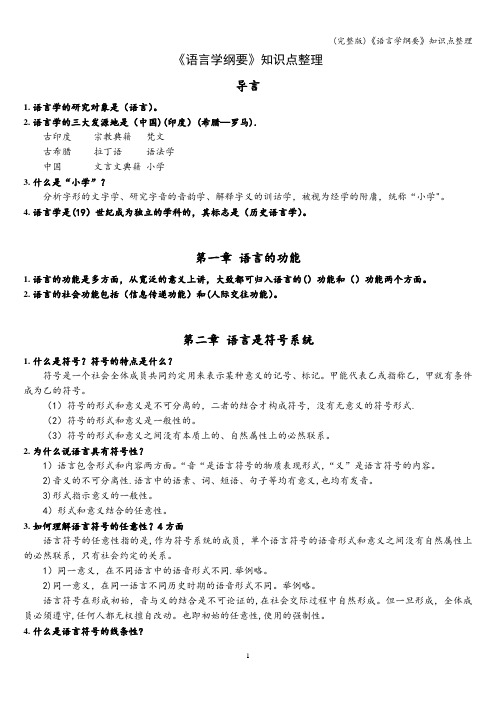
《语言学纲要》知识点整理导言1.语言学的研究对象是(语言)。
2.语言学的三大发源地是(中国)(印度)(希腊—罗马).古印度宗教典籍梵文古希腊拉丁语语法学中国文言文典籍小学3.什么是“小学”?分析字形的文字学、研究字音的音韵学、解释字义的训诂学,被视为经学的附庸,统称“小学"。
4.语言学是(19)世纪成为独立的学科的,其标志是(历史语言学)。
第一章语言的功能1.语言的功能是多方面,从宽泛的意义上讲,大致都可归入语言的()功能和()功能两个方面。
2.语言的社会功能包括(信息传递功能)和(人际交往功能)。
第二章语言是符号系统1.什么是符号?符号的特点是什么?符号是一个社会全体成员共同约定用来表示某种意义的记号、标记。
甲能代表乙或指称乙,甲就有条件成为乙的符号。
(1)符号的形式和意义是不可分离的,二者的结合才构成符号,没有无意义的符号形式.(2)符号的形式和意义是一般性的。
(3)符号的形式和意义之间没有本质上的、自然属性上的必然联系。
2.为什么说语言具有符号性?1)语言包含形式和内容两方面。
“音“是语言符号的物质表现形式,“义”是语言符号的内容。
2)音义的不可分离性.语言中的语素、词、短语、句子等均有意义,也均有发音。
3)形式指示意义的一般性。
4)形式和意义结合的任意性。
3.如何理解语言符号的任意性?4方面语言符号的任意性指的是,作为符号系统的成员,单个语言符号的语音形式和意义之间没有自然属性上的必然联系,只有社会约定的关系。
1)同一意义,在不同语言中的语音形式不同.举例略。
2)同一意义,在同一语言不同历史时期的语音形式不同。
举例略。
语言符号在形成初始,音与义的结合是不可论证的,在社会交际过程中自然形成。
但一旦形成,全体成员必须遵守,任何人都无权擅自改动。
也即初始的任意性,使用的强制性。
4.什么是语言符号的线条性?语言符号在使用中以符号序列的形式出现,符号只能一个跟着一个依次出现,在时间的线条上绵延,不能在空间的面上铺开.5.(组合关系)和(聚合关系)是语言系统中最基本、最根本的结构关系。
大学语言学概论考点整理
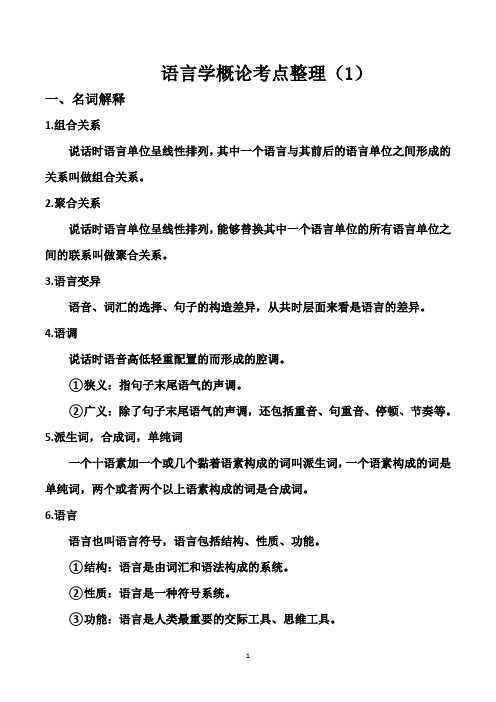
语言学概论考点整理(1)一、名词解释1.组合关系说话时语言单位呈线性排列,其中一个语言与其前后的语言单位之间形成的关系叫做组合关系。
2.聚合关系说话时语言单位呈线性排列,能够替换其中一个语言单位的所有语言单位之间的联系叫做聚合关系。
3.语言变异语音、词汇的选择、句子的构造差异,从共时层面来看是语言的差异。
4.语调说话时语音高低轻重配置的而形成的腔调。
①狭义:指句子末尾语气的声调。
②广义:除了句子末尾语气的声调,还包括重音、句重音、停顿、节奏等。
5.派生词,合成词,单纯词一个十语素加一个或几个黏着语素构成的词叫派生词,一个语素构成的词是单纯词,两个或者两个以上语素构成的词是合成词。
6.语言语言也叫语言符号,语言包括结构、性质、功能。
①结构:语言是由词汇和语法构成的系统。
②性质:语言是一种符号系统。
③功能:语言是人类最重要的交际工具、思维工具。
7.语言结构的层次性(二层性)语言结构包括上层和下层次,上层次性有三种,第一层是语素,第二层是词,第三层是句子。
下层次性是首位,它们的特点是每一层都是上下面一层组合而成。
8.语法范畴把语法意义进一步综合概括形成的意义类别,称为语法范畴。
9.重音重音分为词重音和句重音,词重音是一个词中重读的音节,句重音是一个句子中重读的词或者词组。
10.词、语素、句子①词是能够独立运用的最小的造句单位。
②语素是最小的语音和语义结合体。
③句子是语言的使用单位,句子表达一个完整的意思并体现说话人的态度。
11.义素义素是构成词义的基本要素。
12.隐性结构、显性结构隐性结构:(1)可以是非连续性的;(2)可以是间接成分之间的关系;(3)一个成分可以同其他成分发生多种关系。
显性结构:(1)成分之间是连续的;(2)是直接成分之间的关系;(3)成分之间的关系是单一的。
二、简答题1.音位和音素有什么区别?(1)定义不同音位:具有区别意义作用的最小语音单位。
音素:从音色角度划分出来的最小语音单位。
语言学概论简答题整理
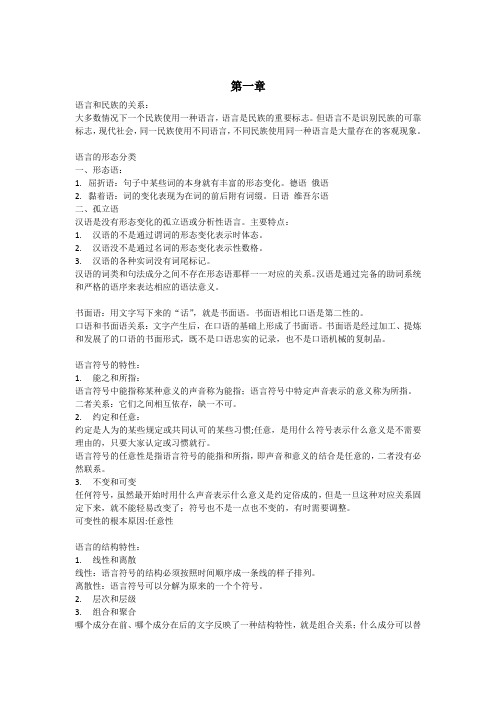
第一章语言和民族的关系:大多数情况下一个民族使用一种语言,语言是民族的重要标志。
但语言不是识别民族的可靠标志,现代社会,同一民族使用不同语言,不同民族使用同一种语言是大量存在的客观现象。
语言的形态分类一、形态语:1.屈折语:句子中某些词的本身就有丰富的形态变化。
德语俄语2.黏着语:词的变化表现为在词的前后附有词缀。
日语维吾尔语二、孤立语汉语是没有形态变化的孤立语或分析性语言。
主要特点:1.汉语的不是通过谓词的形态变化表示时体态。
2.汉语没不是通过名词的形态变化表示性数格。
3.汉语的各种实词没有词尾标记。
汉语的词类和句法成分之间不存在形态语那样一一对应的关系。
汉语是通过完备的助词系统和严格的语序来表达相应的语法意义。
书面语:用文字写下来的“话”,就是书面语。
书面语相比口语是第二性的。
口语和书面语关系:文字产生后,在口语的基础上形成了书面语。
书面语是经过加工、提炼和发展了的口语的书面形式,既不是口语忠实的记录,也不是口语机械的复制品。
语言符号的特性:1.能之和所指:语言符号中能指称某种意义的声音称为能指;语言符号中特定声音表示的意义称为所指。
二者关系:它们之间相互依存,缺一不可。
2.约定和任意:约定是人为的某些规定或共同认可的某些习惯;任意,是用什么符号表示什么意义是不需要理由的,只要大家认定或习惯就行。
语言符号的任意性是指语言符号的能指和所指,即声音和意义的结合是任意的,二者没有必然联系。
3.不变和可变任何符号,虽然最开始时用什么声音表示什么意义是约定俗成的,但是一旦这种对应关系固定下来,就不能轻易改变了;符号也不是一点也不变的,有时需要调整。
可变性的根本原因:任意性语言的结构特性:1.线性和离散线性:语言符号的结构必须按照时间顺序成一条线的样子排列。
离散性:语言符号可以分解为原来的一个个符号。
2.层次和层级3.组合和聚合哪个成分在前、哪个成分在后的文字反映了一种结构特性,就是组合关系;什么成分可以替换出现在某个位置上的问题反映了一种结构特性,是聚合关系。
语言学名著导读整理

语言学名著导读整理一、填空1、《普通语言学教程》是索绪尔唯一的著作,但它是现代语言学经典性的奠基之作。
2、索绪尔是现代语言学和结构主义语言学的创始人,是当之无愧的现代语言学之父。
3、索绪尔《普通语言学》三组重要关系:语言和言语、共识语言学和历时语言学、内部语言学和外部语言学。
4、叶斯伯森将词分为五类:名词、形容词、代词、动词、小品词(副词、介词、连词、感叹词)5、叶斯柏森将语言的关系分为:组合式、连系式6、布隆菲尔德首先区分了自由形式和黏附形式。
7、布龙菲尔德认为语言形式的四种配列方式:词序、变调、变音、形式的选择。
8、生成语法的创始人是乔姆斯基,代表作《最简方案》、《生成语法》9、被看做20世纪最伟大的理论著作是《生成语法》10、乔姆斯基认为儿童对外界世界的发现和判断是通过脑内先天机制产生的。
11、对语言研究采取形式主义演绎研究方法,即伽利略研究风格。
12、当代语言学研究分为形式句法和功能语法。
13、语言类型学的基本研究方法是:跨语言比较。
14、韩礼德语言学的六个核心思想:元功能或纯理功能思想、系统的思想、层次的思想、功能的思想、语境的思想、近似的或盖然的思想。
15、句法象似性的三个原则:距离象似原则、顺序象似原则、数量象似原则。
16、索绪尔《普通语言学教程》叶斯柏森《语法哲学》布龙菲尔德《语言论》乔姆斯基《最简方案》韩礼德《功能语言学导论》克罗夫特《语言类型学和普遍语法特征》二、名词解释1、向心结构:一种结构是向心的,就是其中一个成分可以代替整个结构的功能,该成分叫中心语。
分为两类:并列的,如the boy and girls;从属的,如fresh milk。
2、离心结构:一个结构是离心的,即其中任何一个成分都不能在功能上代替整个结构,如the man fell。
3、黏附形式:不能单说的语言形式叫黏附形式。
如Johnny的-y,playing的-ing。
其他所有的形式都是自由形式。
4、语言类型学:研究各种语言的特征并进行分类的学科。
语言学纲要知识点整理

语言学纲要知识点整理语言学纲要知识点整理一、语言学概述1.语言的定义:语言是人们的代表性、情感的、手段的主要交流方式,是一种具有表达思想和表现感情的一种文化现象,它使用音、词、句、文来表达意义,使用声音、文字、文件把想法交流出来。
2.语言的特点:(1)可用性:语言能够有效传达用语者的思想和信息;(2)多样性:不同的国家和地区有不同的语言;(3)多功能性:语言在道理上用于各种目的,如交流,陈述,相互理解,表达思想,表现情感等;(4)灵活性:语言有语法结构,可以按不同意思组合;(5)可变性:语言在传达意义时可以发生变化;(6)传统性:语言是传统和文化的组成部分,在不同的历史时期也有不同的发展。
二、语言学分支1.古典语言学:古典语言学对语言学的性质、历史演变、比较、发展以及语言结构等方面进行研究,涵盖了古代语言学家的研究成果。
2.现代语言学:现代语言学是从19世纪末以后语言学研究的一种有机统称,基本以科学方法研究语言,对语言特性及其功能和转换的结构及其方式做出系统性的研究。
3.比较语言学:比较语言学是以比较固有语言的形式及其结构为主要研究对象的语言学。
它以比较研究为宗旨,以比较语言的形式及其结构特征、历史变化等为研究对象,也是探讨语言的演变过程的一个重要学科。
三、语言学方法1.语料库:语料库指语料学研究研究对象,是按照一定的话题内容,经过统计、清洗的数据库,其中有现代语言学和社会语言学研究的重要组成部分。
2.实验:实验是根据定义的研究问题、研究目的,制定研究设计、实施实验方案,经过量化、图形处理评价,来检测数据的有效性,以及不同群体的对比实验,以期获得可靠的语言现象的结论。
3.分析:分析是根据实验获得的观察语料,通过观察、比较、识别等方法,分析其构成,推断其内部性质,以期把握及理解语言现象。
4.理论建构:理论建构是在实证数据的基础上,结合实证分析推断出的观点,通过咨询和汇总,进行理性思维,形成语言学的理论。
语言学概论复习重点整理
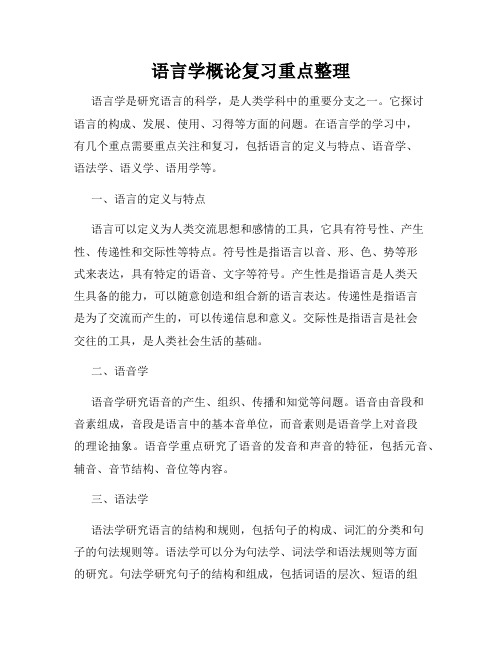
语言学概论复习重点整理语言学是研究语言的科学,是人类学科中的重要分支之一。
它探讨语言的构成、发展、使用、习得等方面的问题。
在语言学的学习中,有几个重点需要重点关注和复习,包括语言的定义与特点、语音学、语法学、语义学、语用学等。
一、语言的定义与特点语言可以定义为人类交流思想和感情的工具,它具有符号性、产生性、传递性和交际性等特点。
符号性是指语言以音、形、色、势等形式来表达,具有特定的语音、文字等符号。
产生性是指语言是人类天生具备的能力,可以随意创造和组合新的语言表达。
传递性是指语言是为了交流而产生的,可以传递信息和意义。
交际性是指语言是社会交往的工具,是人类社会生活的基础。
二、语音学语音学研究语音的产生、组织、传播和知觉等问题。
语音由音段和音素组成,音段是语言中的基本音单位,而音素则是语音学上对音段的理论抽象。
语音学重点研究了语音的发音和声音的特征,包括元音、辅音、音节结构、音位等内容。
三、语法学语法学研究语言的结构和规则,包括句子的构成、词汇的分类和句子的句法规则等。
语法学可以分为句法学、词法学和语法规则等方面的研究。
句法学研究句子的结构和组成,包括词语的层次、短语的组成和句子的句法规则。
词法学研究词汇的构成和分类,包括名词、动词、形容词等的形态学特点和语义学特征。
四、语义学语义学研究语言的意义和语义关系,研究词汇的意义、句子的意义和语义关系的表达方式等。
语义学包括词汇语义学和句子语义学两个方面的内容。
词汇语义学研究词汇的意义和词汇之间的关系,包括语义原理、词汇关系等。
句子语义学研究句子的意义和句子之间的关系,包括句子的逻辑关系、语义角色等。
五、语用学语用学研究语言使用的实际情况,分析语言使用者之间的交际行为和交际行为产生的效果等。
语用学主要研究语言的使用环境、语言行为的目的、语言行为的影响等方面的问题。
例如,研究语言中的礼貌用语、谈话中的暗示和推理、言语行为的意义和效果等。
六、其他相关内容除了以上几个重点内容外,还有一些其他与语言学相关的内容也值得复习和关注。
英语语言学知识点整理
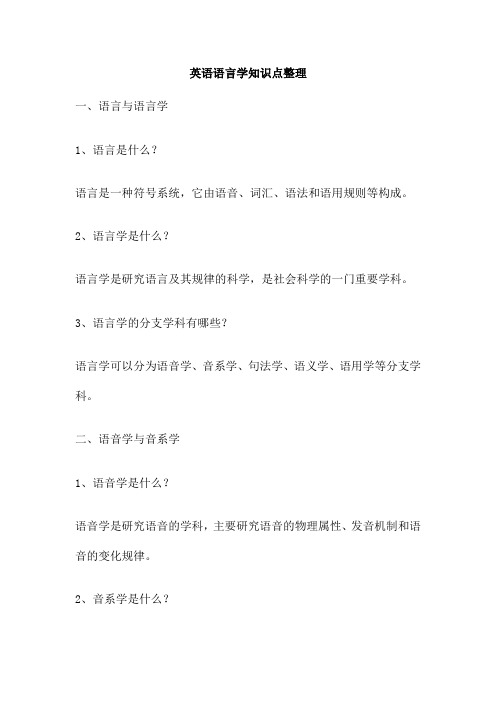
英语语言学知识点整理一、语言与语言学1、语言是什么?语言是一种符号系统,它由语音、词汇、语法和语用规则等构成。
2、语言学是什么?语言学是研究语言及其规律的科学,是社会科学的一门重要学科。
3、语言学的分支学科有哪些?语言学可以分为语音学、音系学、句法学、语义学、语用学等分支学科。
二、语音学与音系学1、语音学是什么?语音学是研究语音的学科,主要研究语音的物理属性、发音机制和语音的变化规律。
2、音系学是什么?音系学是研究语言的音系系统的学科,它的是语言的音位、音素、音节、语素等基本单位以及它们之间的组合关系和变化规律。
3、语音和音系的关系是什么?语音是音系的具体表现形式,而音系则是语音的基础和框架。
语音受到个人的发音和语境的影响,而音系则是一种抽象的概念,它是语言社团所共同遵守的规则。
三、句法学1、句法学是什么?句法学是研究句子的结构和规律的学科。
它主要的是词类、句子成分的构成和它们之间的组合关系。
2、句法学的核心概念有哪些?句法学的核心概念包括:词类、句子成分、句法关系、句型等。
3、常见的句法结构有哪些?常见的句法结构包括:简单句、复合句、并列句、复合并列句等。
四、语义学1、语义学是什么?语义学是研究语言意义的学科,主要研究词义、短语意义、句子意义和语篇意义等。
2、语义的分类有哪些?语义可以分为词汇意义、语法意义和语用意义。
词汇意义是指词汇的基本意义,语法意义是指词汇在句子中的组合关系和变化规律,语用意义是指词汇在特定语境中的特殊意义。
3、语义关系有哪些?语义关系包括:同义关系、反义关系、上下义关系等。
同义关系是指两个或多个词义相同或相似的词语之间的关系,反义关系是指两个或多个词义相反的词语之间的关系,上下义关系是指一个词所表达的概念是另一个词所表达的概念的一部分。
语言学知识点整理语言学是一门研究人类语言的学科,涉及语言的各个方面,包括语言的结构、使用、习得和进化等。
以下是一些常见的语言学知识点:1、语言与言语:语言是指一种符号系统,是人们用来表达思想、情感和意愿的工具。
语言学术语整理

语言学常用术语整理1、传统语法:传统语法是指代表前语言学时期语言研究的特征、特别是18和19世纪欧洲学校语法特征的一系列的看法、程序和规定的语法。
后来被结构主义语言学取代,现代中学教学所用的语法都是传统语法。
传统语法的内容:①把语法分为形态学(词法)和造句法(句法)两大部分,以词法为主,详细讲解各类词在句子中的形态变化和语法作用。
句法往往比较简单,主要为词法服务。
②建立了形态学,研究语法形态和语法意义的对应关系。
③建立了句法成分,主语、谓语、为主要成分,宾语、补语是次要成分,定语、状语是附加成分。
传统语法的特点:①它是规范性的语法,由语法学家订立一些条文,规定人们应该怎么说,不应该怎么说,不顾语言事实。
②它重视书面语,比较少或干脆不考虑口语。
③以拉丁语为楷模,它研究语法照搬拉丁语法框架。
④语言分析中重视意义,忽视形式。
⑤忽视语言结构层次。
贡献:虽然传统语法有许多缺点,但它作为语言学史上的第一个语法学派奠定了语法学基础,对普及语法知识起到了巨大的作用;虽然现在语法学派林立,但名词、动词、形容词、语法形式、语法意义、语法手段、主语、宾语等语法范畴在各学派的体系中仍然使用,所以说传统语法对语法学具有开创作用。
2、结构主义语法:结构主义语法是在对传统语法评判的基础上建立起来的,创始人是瑞士语言学家索绪尔,经典著作是《普通语言学教程》,提出了一整套语言学理论。
后来发展成三个分支学派:布拉格学派、哥本哈根学派和美国描写语言学派。
其中以美国描写语言学派的影响最大,代表人物是布龙菲尔德,集大成者是哈里斯。
结构主义语法的基本主张:①语法只能是描写语言,即说明人们怎样说一种语言,而不能像传统语法那样规定人们该怎么说。
②语法必须从形式出发描写语言,而不是像传统语法那样从意义出发来探讨语言。
提出根据分布划分词类。
③强调语言的内部层次,提出用“直接成分分析法”对句法结构进行分析。
④语言单位切分的方法:替代法、分布、转换法、对比分析法。
《语言学概论》整理
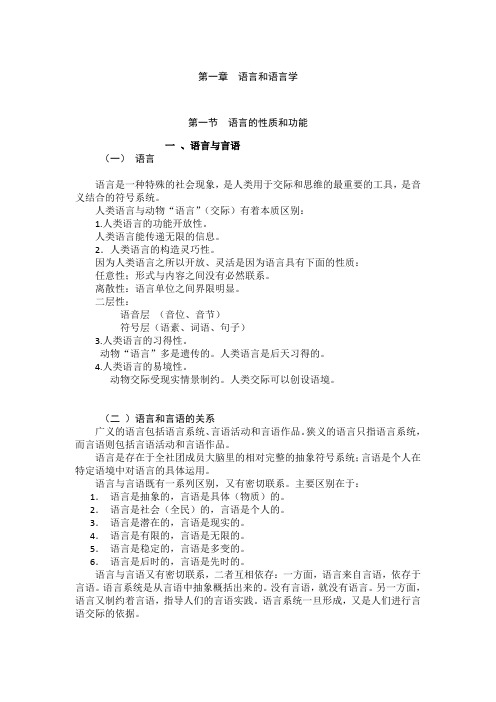
第一章语言和语言学第一节语言的性质和功能一、语言与言语(一)语言语言是一种特殊的社会现象,是人类用于交际和思维的最重要的工具,是音义结合的符号系统。
人类语言与动物“语言”(交际)有着本质区别:1.人类语言的功能开放性。
人类语言能传递无限的信息。
2.人类语言的构造灵巧性。
因为人类语言之所以开放、灵活是因为语言具有下面的性质:任意性;形式与内容之间没有必然联系。
离散性:语言单位之间界限明显。
二层性:语音层(音位、音节)符号层(语素、词语、句子)3.人类语言的习得性。
动物“语言”多是遗传的。
人类语言是后天习得的。
4.人类语言的易境性。
动物交际受现实情景制约。
人类交际可以创设语境。
(二)语言和言语的关系广义的语言包括语言系统、言语活动和言语作品。
狭义的语言只指语言系统,而言语则包括言语活动和言语作品。
语言是存在于全社团成员大脑里的相对完整的抽象符号系统;言语是个人在特定语境中对语言的具体运用。
语言与言语既有一系列区别,又有密切联系。
主要区别在于:1.语言是抽象的,言语是具体(物质)的。
2.语言是社会(全民)的,言语是个人的。
3.语言是潜在的,言语是现实的。
4.语言是有限的,言语是无限的。
5.语言是稳定的,言语是多变的。
6.语言是后时的,言语是先时的。
语言与言语又有密切联系,二者互相依存:一方面,语言来自言语,依存于言语。
语言系统是从言语中抽象概括出来的。
没有言语,就没有语言。
另一方面,语言又制约着言语,指导人们的言语实践。
语言系统一旦形成,又是人们进行言语交际的依据。
二语言的性质(一)语言的符号性用甲事物代表乙事物,而甲乙两事物之间没有必然的联系,甲事物就是代表乙事物的符号。
其中甲事物就是符号的能指(形式),乙事物就是符号的所指(内容、意义)。
符号都具有任意性和约定性。
任意性是指能指与所指之间没有必然联系。
是符号最根本的属性。
约定性是指能指与所指之间的联系是人为约定的,一旦约定人们就要遵守这种社会共同的约定。
语言学概论蓝纯笔记整理
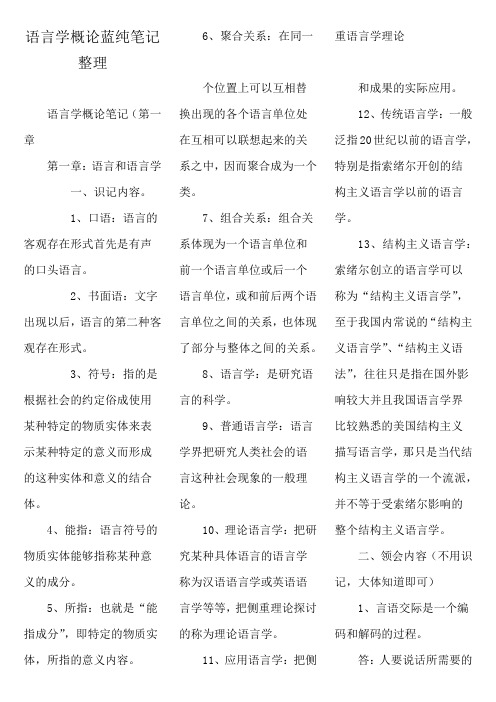
语言学概论蓝纯笔记整理语言学概论笔记(第一章第一章:语言和语言学一、识记内容。
1、口语:语言的客观存在形式首先是有声的口头语言。
2、书面语:文字出现以后,语言的第二种客观存在形式。
3、符号:指的是根据社会的约定俗成使用某种特定的物质实体来表示某种特定的意义而形成的这种实体和意义的结合体。
4、能指:语言符号的物质实体能够指称某种意义的成分。
5、所指:也就是“能指成分”,即特定的物质实体,所指的意义内容。
6、聚合关系:在同一个位置上可以互相替换出现的各个语言单位处在互相可以联想起来的关系之中,因而聚合成为一个类。
7、组合关系:组合关系体现为一个语言单位和前一个语言单位或后一个语言单位,或和前后两个语言单位之间的关系,也体现了部分与整体之间的关系。
8、语言学:是研究语言的科学。
9、普通语言学:语言学界把研究人类社会的语言这种社会现象的一般理论。
10、理论语言学:把研究某种具体语言的语言学称为汉语语言学或英语语言学等等,把侧重理论探讨的称为理论语言学。
11、应用语言学:把侧重语言学理论和成果的实际应用。
12、传统语言学:一般泛指20世纪以前的语言学,特别是指索绪尔开创的结构主义语言学以前的语言学。
13、结构主义语言学:索绪尔创立的语言学可以称为“结构主义语言学”,至于我国内常说的“结构主义语言学”、“结构主义语法”,往往只是指在国外影响较大并且我国语言学界比较熟悉的美国结构主义描写语言学,那只是当代结构主义语言学的一个流派,并不等于受索绪尔影响的整个结构主义语言学。
二、领会内容(不用识记,大体知道即可)1、言语交际是一个编码和解码的过程。
答:人要说话所需要的因素:生活经历、社会环境、当前处理的问题、社会问题、文化问题、哲学问题、逻辑问题。
人要接受语言所需要的因素:组织与分析的能力、心理、生理问题;发音、听音的器官和神经网络及机制和能力;复杂的生理和物理问题。
总之一句话,言语交际是通过许多因素对语言进行编码和解码的过程,言者编码,听者解码。
语言学概要整理笔记【精选文档】
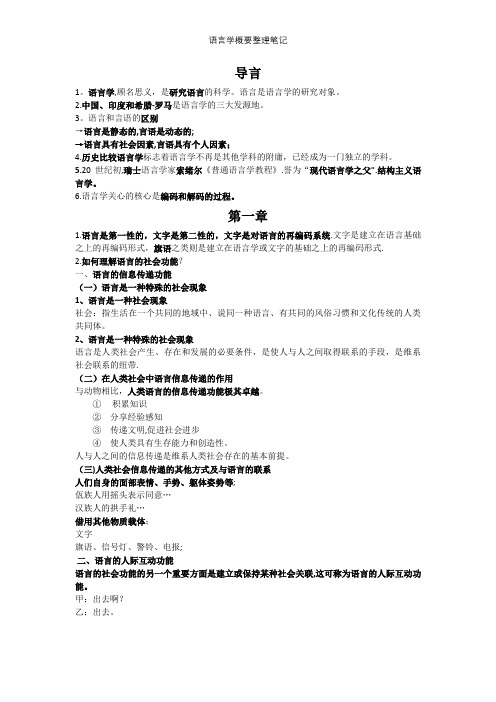
导言1。
语言学,顾名思义,是研究语言的科学。
语言是语言学的研究对象。
2.中国、印度和希腊-罗马是语言学的三大发源地。
3。
语言和言语的区别→语言是静态的,言语是动态的;→语言具有社会因素,言语具有个人因素;4.历史比较语言学标志着语言学不再是其他学科的附庸,已经成为一门独立的学科。
5.20世纪初,瑞士语言学家索绪尔《普通语言学教程》.誉为“现代语言学之父".结构主义语言学。
6.语言学关心的核心是编码和解码的过程。
第一章1.语言是第一性的,文字是第二性的,文字是对语言的再编码系统.文字是建立在语言基础之上的再编码形式,旗语之类则是建立在语言学或文字的基础之上的再编码形式.2.如何理解语言的社会功能?一、语言的信息传递功能(一)语言是一种特殊的社会现象1、语言是一种社会现象社会:指生活在一个共同的地域中、说同一种语言、有共同的风俗习惯和文化传统的人类共同体。
2、语言是一种特殊的社会现象语言是人类社会产生、存在和发展的必要条件,是使人与人之间取得联系的手段,是维系社会联系的纽带.(二)在人类社会中语言信息传递的作用与动物相比,人类语言的信息传递功能极其卓越。
①积累知识②分享经验感知③传递文明,促进社会进步④使人类具有生存能力和创造性。
人与人之间的信息传递是维系人类社会存在的基本前提。
(三)人类社会信息传递的其他方式及与语言的联系人们自身的面部表情、手势、躯体姿势等;佤族人用摇头表示同意…汉族人的拱手礼…借用其他物质载体;文字旗语、信号灯、警铃、电报;二、语言的人际互动功能语言的社会功能的另一个重要方面是建立或保持某种社会关联,这可称为语言的人际互动功能。
甲:出去啊?乙:出去。
人际互动功能表达了说话者的一种主观态度,是一种特殊的信息传递,它指向交际本身.简单地说,就是人在很多情况下是为了交际而交际。
人际互动包括两个方面:-说话者在话语中表达自己的情感、态度、意图;-对受话者施加了影响,得到相应的语言或行动上的反馈,从而达到某种实际效果.交际双方在主观情态表达上是彼此互动的.3.思维是认识现实世界时的动脑筋的过程,也指动脑筋时进行比较、分析、综合以认识现实的能力。
语言学概论试题整理
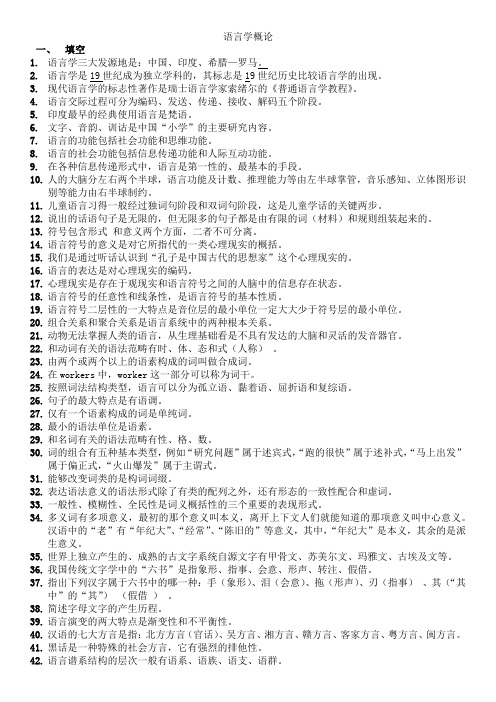
语言学概论一、填空1.语言学三大发源地是:中国、印度、希腊—罗马。
2.语言学是19世纪成为独立学科的,其标志是19世纪历史比较语言学的出现。
3.现代语言学的标志性著作是瑞士语言学家索绪尔的《普通语言学教程》。
4.语言交际过程可分为编码、发送、传递、接收、解码五个阶段。
5.印度最早的经典使用语言是梵语。
6.文字、音韵、训诂是中国“小学”的主要研究内容。
7.语言的功能包括社会功能和思维功能。
8.语言的社会功能包括信息传递功能和人际互动功能。
9.在各种信息传递形式中,语言是第一性的、最基本的手段。
10.人的大脑分左右两个半球,语言功能及计数、推理能力等由左半球掌管,音乐感知、立体图形识别等能力由右半球制约。
11.儿童语言习得一般经过独词句阶段和双词句阶段,这是儿童学话的关键两步。
12.说出的话语句子是无限的,但无限多的句子都是由有限的词(材料)和规则组装起来的。
13.符号包含形式和意义两个方面,二者不可分离。
14.语言符号的意义是对它所指代的一类心理现实的概括。
15.我们是通过听话认识到“孔子是中国古代的思想家”这个心理现实的。
16.语言的表达是对心理现实的编码。
17.心理现实是存在于观现实和语言符号之间的人脑中的信息存在状态。
18.语言符号的任意性和线条性,是语言符号的基本性质。
19.语言符号二层性的一大特点是音位层的最小单位一定大大少于符号层的最小单位。
20.组合关系和聚合关系是语言系统中的两种根本关系。
21.动物无法掌握人类的语言,从生理基础看是不具有发达的大脑和灵活的发音器官。
22.和动词有关的语法范畴有时、体、态和式(人称)。
23.由两个或两个以上的语素构成的词叫做合成词。
24.在workers中,worker这一部分可以称为词干。
25.按照词法结构类型,语言可以分为孤立语、黏着语、屈折语和复综语。
26.句子的最大特点是有语调。
27.仅有一个语素构成的词是单纯词。
28.最小的语法单位是语素。
- 1、下载文档前请自行甄别文档内容的完整性,平台不提供额外的编辑、内容补充、找答案等附加服务。
- 2、"仅部分预览"的文档,不可在线预览部分如存在完整性等问题,可反馈申请退款(可完整预览的文档不适用该条件!)。
- 3、如文档侵犯您的权益,请联系客服反馈,我们会尽快为您处理(人工客服工作时间:9:00-18:30)。
语言学模拟题(干明版)一、填空题1.语言是人类社会的(最重要的交际工具),而且也是思维的(最有效的工具)。
2.语言符号具有(任意性)和(线条性)特点。
3.语言的底层是一套(音位),上层是符号和符号的(序列),可以分为若干级,第一级是(语素),第二级是(词),第三级是由词构成的句子。
4.语言系统中的所有符号,既可以同别的符号组合,又可以被别的符号替换,符号之间的这两种关系是(组合关系)和(聚合关系)。
5.(组合)关系是指构成线性序列的语言成分之间的结构关系,(聚合)关系是指在线性序列的同一位置上不同结构单位的替换规则。
6.从物理属性角度看,语音具有(音高)、(音重)、(音长)、(音质)四个要素,汉语的声调,就是由于(音高)的变化形成的。
7.人类发音器官分(动力)、(发音体)、(共鸣器)三大部分,(共鸣器)部分主要作用是调节气流,许多不同的音素,就是这一部分的变化形成的。
8.音素可分(元音)和(辅音)两大类,其区别的根本点是发音时气流在口腔中是否(受阻碍)。
9.元音的音质是由(舌位高低)、(舌位前后)、(嘴唇圆展)三个方面决定的,例如[A]是(舌位低)(舌面中)(不圆唇)。
10.辅音的发音特征是由(发音部位)(发音方法)决定的。
例如[p]是(双唇)(清)(塞)(不送气)。
11.具体语言中具有区别词的语音形式的作用的最小语音单位就是(音位)。
12.音位变体可分(条件变体)、(自由变体)两类,例如汉语某些方言中,声母“l”可以无条件地换成“n”,这两个音位就是(自由变体)。
13.汉语音节可分(声母)(韵母)(声调)三部分,其中(韵母)又可分(韵头)、韵腹和(韵尾)。
14.汉语i和y 的区别是(圆唇与否)不同,其它两个方面都相同。
15.人们在说话时,常常把[toufu](豆腐)说成[touf],这种音变现象叫做(脱落)。
16.语法的(组合规则)和(聚合规则)构成一种语言的语法规则。
17.我们可以根据语素在词中的不同作用把它们分为三类,例如happinesses中,es是(词尾),ness是(后缀),happi是(词根)。
18.合成词“发指”的结构方式是(陈述式)。
19.“西瓜大”和“大西瓜”的(词序)不同,结果语法意义也不一样。
20.词的组合有五种基本方式,例如“研究问题”是(述宾结构),“跑得很快”是(述补结构),“火速准备”是(偏正结构),“我们努力”是(主谓结构)。
21.孤立语的主要特点是缺乏(词形变化);屈折语的主要特点是有丰富的(词形变化)。
22.基本词汇具有(普遍性)、(稳固性)、(能产性)三个特点。
23.(一般性)、(模糊性)、(全民性)是词义概括性的三个重要的表现形式。
24.多义词有多项意义,最初的那项意义叫(本义),离开上下文人们就能知道的那项意义叫(中心意)。
例如“老”有“年纪大”、“经常”、“过去的”等意义,“年纪大”是(本义),其余的是(派生意)。
25.派生义的产生方式主要有(隐喻)和(换喻)两种。
26.反义词可分(相对反义词)和(绝对反义词)两类。
例如“老年”与“少年”是(相对反义词)。
27.文字突出的作用是打破了有声语言的(时间)、(空间)的局限性,扩大了有声语言的使用范围。
28.文字包括(字形)、(字音)、(字义)三个方面,这三方面在文字中缺一不可。
29.在文字产生以前,人类使用(实物记事)和(图画记事)帮助记忆。
30.各种不同体系的意音文字都包含(表意字)、(表音字)和(形声字)三种不同类型的字形。
31.人类造字的方法主要有(表意)和(表音)两种。
32.(渐变性)和(不平衡性)是语言发展的两大特点。
33.语言的发展中,(词汇)的变化速度最快,(语音)次之,而(语法)的演变最为缓慢。
34.在一个多民族的国家中,各民族之间往往还需要一个共同的交际工具,这就是所谓的(国家共同语),我国的(普通话)就是这样的一种共同语。
35.汉语的普通话,根据规范化的要求,确定为以(北京语音)为标准音,以(北方话)为基础方言,以(典范的现代白话文著作)为语法规范。
36.在(双语现象)阶段,必然会产生语言间的相互影响,即使是被替代的语言,也会在胜利者的(语言)中留下自己的痕迹。
37.(洋泾浜(皮钦语))和(混合语(克里奥耳))都是语言接触的一些特殊形式。
38.世界语是由波兰医生(柴门霍夫)于(1887)年创造的一种国际辅助语。
39.语音演变的三个特点是(一定的条件限制)、时间性、(地区性)。
40.有的方言随着社会的分化可以变成(亲属语言),它们之间存在着语音(对应关系)。
人们正是根据这种关系来确定(语言亲属关系)的。
41.语法的发展主要表现在语法的(组合规则)、(聚合规则)的演变和语法发展中的(类推作用)。
42.语法组合规则的发展主要表现为(词序)的改变,语法聚合规则的发展主要表现为(形态)的改变、(语法范畴)的消长和(词类)的发展43.“戏子”现称“演员”、“金陵”现称“南京”,这属于词语的(替换)。
二、选择题D 音素i和y的差别是由的差别形成的。
A、音高B、音重C、音长D、音质A [p]、[t]、[k]都是。
A、塞音B、檫音C、塞檫音D、边音A [p’]、[t’]、[k’]三个音素的区别是不同。
A、发音部位B、发音方法C、送气与否D、清浊D 元音和辅音最本质的区别是。
A、声带振动与否B、是否均衡紧张C、时间延续久暂D、气流是否受阻B 元音[o]具有下列发音特征中的。
A、高元音B、圆唇元音C、低元音D、前元音B 汉语普通话语音系统中没有发音部位。
A、双唇B、齿间C、唇齿D、舌面前D 与国际音标[x]相对应的汉语音素是。
A、yB、kC、qD、hD下列各组词中,全都属于复合词的一组是。
A、大学、人民、(英)readerB、劳动、阿姨、(英)railwayC、瓶子、老虎、(英)unhappyD、道路、材料、(英)classroomB英语名词后面加上词尾s或es,这种变化属于语法范畴中的变化。
A、性B、数C、格D、体C与“春光明媚”结构相同的组合是。
A、阳光的温暖B、已经弄开始C、The sun riseD、Worker and PeasantD下列句子没有多义的是。
A、甲方在今年为乙方培养四个试验室工作人员。
B、日本保留和尚使用的庙宇不多了。
C、我今年还欠款50000元,明年就好过多了。
D、我的老师和同学都特别喜欢我拍的这部片子。
A下列句子有歧义的一句是。
A、很明显,他这个人谁都认识。
B、新的教师宿舍已经修好了。
C、热爱人民的周总理向我们招手。
D、靠山吃山总有吃光的一天啊。
C 下列属于汉语借词的是()A、雷达足球芭蕾舞B、卡车电话哈马狗C、纳粹吉他比萨饼D、沙龙朝廷艾滋病D“铁路”、“火箭炮”、“机关枪”属于()A、借词B、音译C、音译加音译D、意译词B下列各种说法,()是正确的。
A、双语现象就是一个人会说两种语言。
B、“葡萄”、“狮子,’、“和尚”都是借词。
C、皮钦语就是克里奥耳语。
D、混合语就是一个人说话夹杂着外来词。
C柴门霍夫所创造的世界语是( )A、世界共同语B、洋泾浜C、国际辅助语D、克里奥耳语A语音演变的主要内容是指()。
A、音位系统的演变B、音素的增加C、浊音清化D、词的读者变化C古汉语声母中有[b]、[d]、[g]、[p] [t、] [k] [p’] [t’][k’],现已合流了,这条语音规律叫做()。
A、腭化规律B、清音浊化规律C、浊音清化规律D、浊音送气化规律B汉语中古音的浊音音位[b],到了现代汉语普通话中变成了[p] [p’],这属于()。
A、语流音变B、条件音变C、无条件的音变D、音位的对立D中古英语的“wifeman(妇女)”由“wife(女人)”和“man(人)”构成,是个复合词。
后来这个词中的“wife”由于发音上的原因演变为“wo",现代英语中的“woman(妇人)”成为一个词了。
这是()。
A、句法的变化引起了词的结构的变化B、语音的变化引起了词汇的变化C、语法的变化引起了词的结构的变化D、语音的变化引起了词的结构的变化D汉语中的“了、着、过”在古代具有实实在在的词汇意义,到了现代已成为表示类似的意义的构形语素,这是()。
A、词序的变化B、类推C、异化D、新的语法范畴形成B古英语中“book(书)”的复数形式是“bec”,到现代变成了“books”,这属于()。
A、形态的变化B、类推C、异化、D、新的语法形式的形成C在社会变动较大或政治斗争激烈的时期,语言中变化最大的是( ) 。
A、语音B、词义C、词汇D、语法B “社稷”、“太监”、“丞相”、“符节”等词在现代汉语中已不再使用,它属于()。
A、词义的演变B、旧词的消亡C、新词的产生D、词语的替换三、判断题1.思维离不开语言,语言也离不开思维。
(√)2.没有语言,人类照样可以思维。
(×)3.语言在无阶级社会没有阶级性,在有阶级社会具有阶级性。
(×)4.从本质上看,语言其实是一种符号系统。
(√)5.语言符号具有任意性特点,就是说我们平时说话用什么样的语音代表什么样的意义是自由的,不受任何约束。
(×)6.通过符号的任意性特点,我们可以解释为什么人类社会有各种各样的语言。
(√)7.语言系统是由不同层级构成的,低一级的单位少,组成高一级后数量翻番增加。
(√)8.音素具有区别词的语音形式的作用。
(×)9.国际音标中有些符号由两个字母组成。
(√)10.不同的元音音素是因为舌位的高低形成的。
(×)11.声母和韵母是音素的两个类别。
(√)12.元音[i]和[u]的区别主要是舌位前后不同。
(×)13.[a]、[A]、[ ]是汉语普通话中同一音位的三个自由变体。
(√)14.[g]和[k]在汉语普通话中是两个不同的音位。
(×)15.非音质音位同样具有区别词的语音形式的作用。
(√)16.音位/t//t'//n//1/具有某些相同的特征,可以形成一个聚合群。
(√)17.文字的主要作用是记录了人类的文化。
(×)18.书面语的发展、总是要先于口语发展。
(×)19.意音文字中的表音字,其实就是拼音文字。
(×)20.汉字与汉语的音节是对应的,一个汉字记录一个音节,一个音节只用一个汉字记录。
(×)21.语言的发展都具有渐变性。
(√)22.语言里语音、词汇、语法的发展是齐头并进的。
(×)23.语言发展也有先于社会发展的情况。
(×)24.意译词是借词的一种类型。
(×)25."洋泾浜"一旦被社会采用为主要交际工具,就会发展成为克里奥耳语。
(√)26.英语中借词比重大,约占词语总数的一半,所以英语实际上是一种混合语。
(×)27.洋泾浜和皮钦语是两个不同的概念。
